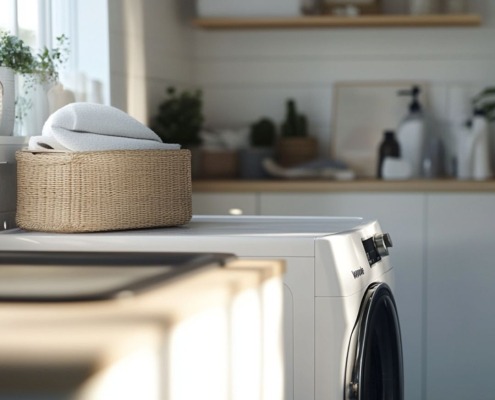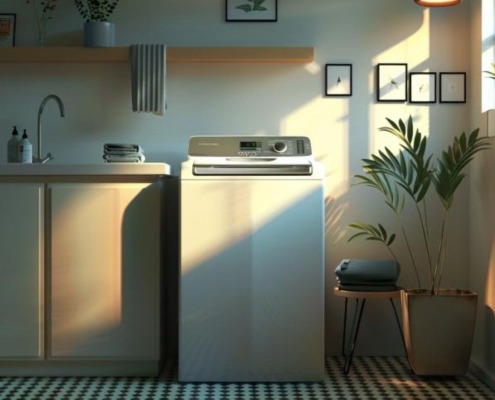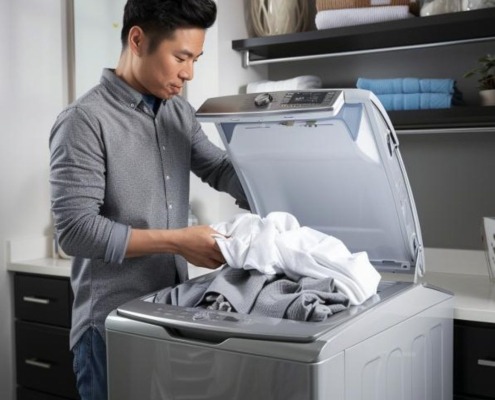How to Fix a GE Top Load Washer Lid That Won’t Unlock
Steven E / Friday June 20, 2025
A locked lid on your GE top-load washer can be frustrating, especially when laundry is stuck inside. We’ll break down why it’s happening and how to get it open quickly.
If you need any replacement parts for your GE top load washer, you can enter your model number at AppliancePartsPros.com to order them. Most orders arrive in just two business days, and we have thousands of free guides to show you how to install your new parts.
The information in this article may not apply to your specific appliance model. We recommend consulting your manufacturer’s documentation or contact us with any questions.
Necessary supplies
- 1/4 inch nut driver
- Multimeter with narrow pin extensions
Safety tips
When working on any appliance, remember to keep safety first. Here are some tips to keep in mind:
- Always power off and unplug your appliance or switch off the circuit breaker before you attempt any maintenance or replacement work. This keeps you safe by eliminating any risk of electric shock.
- If the appliance has recently been used, give it plenty of time to cool down before working on it.
- Take your time while working to prevent accidents and personal injuries. Rushing is the enemy of precision.
- Work in a well-lit area so you can see and access appliance parts.
- Keep your workspace free of clutter and other obstacles. Keep children and pets away from the work area.
- Never work on internal parts with wet hands. Make sure the work area is completely dry.
- Check the user manual to see if there are specific installation or safety instructions related to your appliance or replacement part.
- Be gentle when handling or removing parts. Excessive force might damage the appliance or cause personal injury.
- Wear insulated work gloves to protect your hands from sharp metal parts and debris.
- When working with wires, avoid touching any exposed wires or terminals. If you need to touch a wire, use a non-conductive tool or wear insulating gloves to prevent electrical shock.
- Always take photos or make a note of wiring terminals or other connections before disconnecting them to make reassembly easier.
- Don’t test live voltage with a multimeter if you’re unfamiliar with how to prevent short-circuiting.
- Consider wearing safety glasses and/or a dust mask when working with chemicals, dust or a large amount of debris to prevent irritation or injury.
- Turn off the water supply at the outlet before beginning repairs. Keep towels ready to catch any residual water in the system when removing parts.
How to troubleshoot a GE top load washer lid that won’t unlock
Follow these steps to troubleshoot and fix a GE top load washer lid that won’t unlock by checking the lid strike, lid switch, and main control board.
Step 1: Check the lid strike
- Open the washer lid to access the lid strike.
- Locate the lid strike, which is mounted to the lid with screws.
- Check if the lid strike is loose, misaligned, or damaged.
- Tighten any loose screws to secure the lid strike.
- If the lid strike is broken, replace it with a new one.
- If the lid strike is in good condition, move on to testing the lid switch.
Step 2: Test the lid switch
- Unplug the washer from the power source.
- Move to the back of the washer.
- Use a 1/4-inch nut driver to remove the screws securing the access panel.
- Slide the access panel to the right to release the tabs and remove it.
- Pull back on the console to unlock it and rotate it forward to access the control board.
- Locate the J513 lid switch wiring harness on the control board.
- Press the locking tab and unplug the lid switch wiring harness.
- Set a multimeter to ohms (Ω) mode.
NOTE: Generally, for every 1 degree in temperature difference, 2 Ohms could be added or subtracted. If the temperature in your home is cooler, resistance would be subtracted.
- Place one test lead on the white wire and the other on the blue wire in the wiring harness.
- Close the washer lid.
- Check the resistance reading on the multimeter. It should be between 60–110 ohms.
- If the reading is outside this range, the lid lock assembly is faulty and must be replaced.
- If the reading is within range, reconnect the lid switch wiring harness to J513 on the control board.
- Lock the wiring harness securely in place.
- If the lid switch is working properly, move on to testing the main control board.
Step 3: Test the main control board
LIVE VOLTAGE WARNING: For this test, the washer needs to be plugged in and powered on. Please be very careful to protect yourself from electric shock, which has the potential to cause serious injuries. Don’t ever test live voltage if you’re uncomfortable using a multimeter.
- Plug the washer back into the power source.
- Hold the Start button while turning the main control knob seven clicks in either direction.
- Release the Start button.
- Turn the main control knob clockwise until the display matches Test 14.
- Tilt the control panel forward again to access the main control board.
- Locate the J513 connector on the board.
- Set a multimeter to Volts AC (V~) mode.
- Place one probe into the red wire and the other into the blue wire of the J513 connector.
- Press the Start button on the control panel to begin the spin test.
- Check the voltage reading on the multimeter. It should be approximately 120V AC.
- If 120V AC is present, the control board is working, and the issue is likely with the lid switch or lid lock assembly.
- If 120V AC is not present, the main control board is faulty and must be replaced.
More for you
Thank you for reading! We hope this guide helped you get your GE top load washer working again.
If you have any other appliance repair needs or projects, don’t hesitate to explore our other troubleshooting guides and videos.
If you need replacement parts or some extra help with ordering them, grab your model number and head over to AppliancePartsPros.com, where you can chat with a pro, read our DIY blog and more.
Don’t forget to subscribe to us on YouTube and follow us on Facebook, Twitter and Instagram!
With nearly a decade of experience in providing top-notch customer service regarding appliance parts and repair, Steven enjoys sharing practical advice, troubleshooting tips, and interesting information to help readers stay informed.





